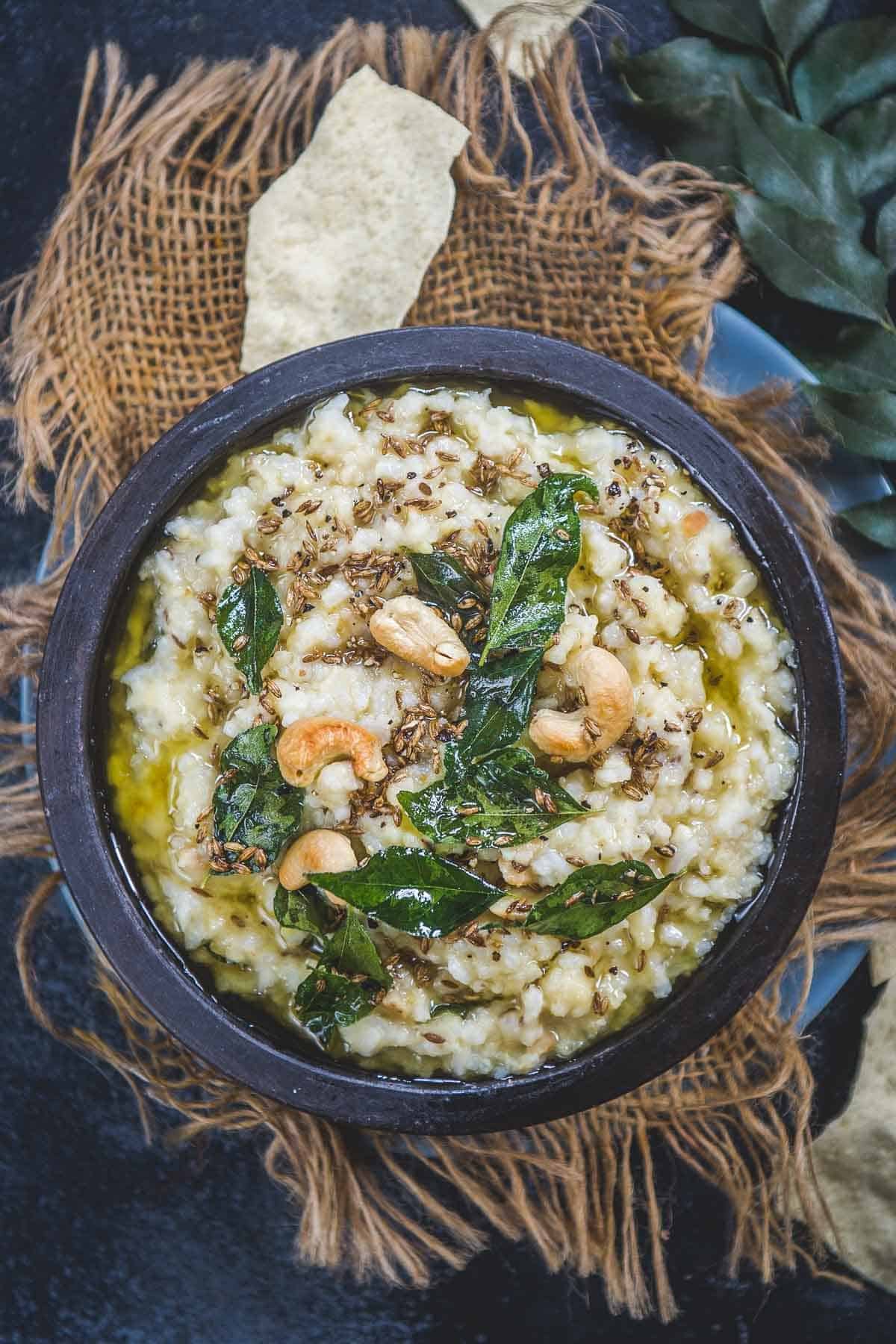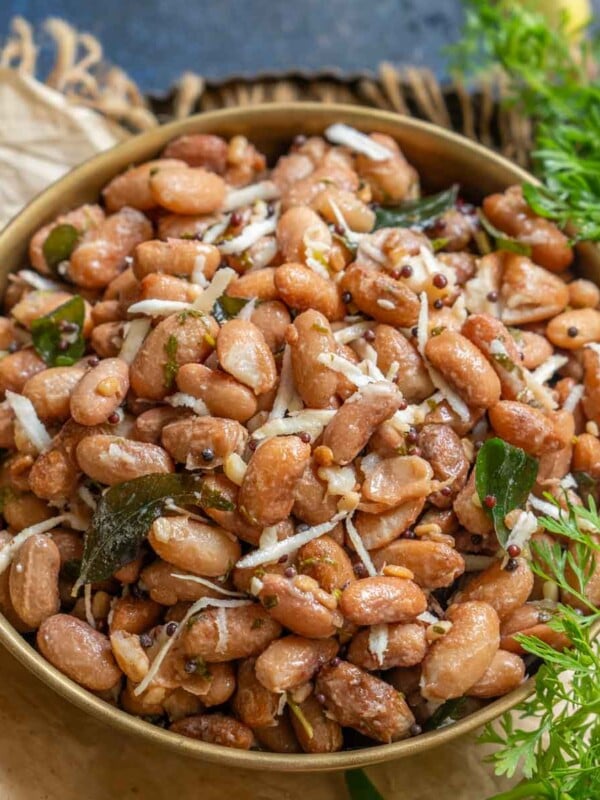on Mar 04, 2021, Updated Aug 30, 2023 If you like South Indian cuisine, then try these recipes: Cabbage Pachadi, Mullangi Sambar, Mor Kuzhambu, and Plain Salna. North Indian khichdi got a South Indian makeover—that’s Ven Pongal. I love khichdi, but if I had to choose between it and Pongal, I would shamelessly choose Pongal any day. Pongal is a flavor explosion inside your mouth. Black peppercorns, curry leaves, loads of ghee, cumin seeds, and asafetida all come together to create a magic that is difficult to explain. In this post, I am sharing a South Indian temple-style ven pongal recipe I learned from one of my neighbors in Bangalore. It’s super easy, uses few ingredients, and tastes delicious and comforting. You can make it in a traditional pressure cooker or instant pot. Read along!
About Ven Pongal (Khara Pongal)
Ven Pongal (Khara Pongal, Ghee Pongal) is a popular South Indian-style savory porridge made using short-grain rice, yellow moong lentils, and spices. It is a variation of North Indian Yellow Moong Dal Khichdi. It is a flavorful and comforting dish made for festivals (especially Sankranti or Pongal festivals) and on auspicious days to be offered as naivedhyam (prasadam, offerings) to gods in homes and temples. Apart from festivals, it is also suitable for everyday meals, as it is light on the stomach and easy to make. Ghee pongal can be served for breakfast, lunch, or dinner with side dishes like white coconut chutney, sambar, or gotsu. I like to serve things with plain yogurt and papad to keep things light. Every home in South India has its recipe for pongal. There is the Iyengar Style and the Andhra Style. Temples and hotels have their recipes for this dish. The only thing common is the use of rice and yellow moong dal. The proportion of dal and rice may also vary from home to home, though. Rice – Traditionally, Pongal is made using freshly harvested Sona Masuri rice and moong dal, which are soft and give a gooey texture. But this should not deter you from making it with whichever rice and lentils you have. If you don’t have Sona Masuri rice, use any short-grain, flavorful white rice, such as Jeera Samba, Surti Kolam, or Indrayani. Ideally, newly harvested dal and rice are best for making this dish as they give it a creamy texture. Yellow Moong Lentil – You will need yellow moong dal (husked and split petite yellow lentils). Ghee tempering changes the way pongal tastes. Traditionally, cow’s ghee is used to temper it, but you can use buffalo ghee, too. Others – You will also need asafetida (hing), ginger, cumin seeds, curry leaves, green chilies, cashew nuts, and black peppercorns. Avoid adding asafetida in the tempering if you want to make it gluten-free. You can adjust green chili peppers as per your preference. Cashew nuts add a great crunch to the soft pongal, so do not skip them. Black peppercorns are a must in this recipe. The flavors from black peppercorns enhance the taste of a simple ven pongal. Some people add whole black peppercorns to their recipe, but it gets overwhelming if you bite into one of these. I like to crush them coarsely in a mortar and pestle. This way, they make the pongla very flavorful without being too overpowering. Air dry for 30 minutes. Rinse ½ cup sona masuri rice and keep it aside. Press the SAUTE button, and add the dal to the instant pot. Roast the lentils until fragrant (5-6 minutes), stirring frequently. Add the following ingredients and stir well.
3 cups of water 1 teaspoon salt 1 teaspoon grated ginger
Close the lid and set the valve to the sealing position. Press PRESSURE COOK and set the timer at high pressure for 12 minutes. Once the timer goes off, let the pressure release naturally for 10 minutes. Release the remaining pressure by moving the valve to the venting position and open the lid. Mash the pongal until slightly creamy. Add more water if needed. Check for salt and add more if needed. Now add the following ingredients to the cooker and stir gently.
4 cups of water 1 teaspoon grated ginger 1 teaspoon salt
Pressure cook for one whistle on high heat. Reduce the heat to low and cook for 12 minutes. Remove the pressure cooker from heat and let the pressure release naturally. Open the lid and lightly mash the pongal with the back of a ladle until it is slightly mushy and creamy. Add more water if the mixture is too thick. It should have the consistency of a porridge. Check for salt and add more if needed. Add the following ingredients once the ghee is hot, and let them crackle for 4-5 seconds.
1 teaspoon cumin seeds ¼ teaspoon asafetida 10-12 whole curry leaves 2-3 green chilies (slit into half) 10-12 coarsely crushed black peppercorns
Add 10-12 whole cashew nuts and fry until slightly browned (1-2 minutes). Stir continuously while frying. Pour the tempering over the pongal and mix well. Serve hot. Tip – Save some tempering for garnishing. The dal and rice ratio can be changed according to your personal preference. I like to use 50:50 dal and rice, but some people use more rice and less dal. To save time, roast moong dal in bulk, cool it, and store it in an airtight container. Then, you can use it to make pongal. If you have leftover pongal, add some water before refrigerating it. It will thicken when refrigerated, but adding water will maintain its consistency. Some people make very thick Pongal. Use less water if you like that consistency, as the recipe mentions. I like the consistency a little flowy. If the pongal is watery, cook it for 3-4 minutes on medium heat until the right consistency is achieved. To make this recipe healthier, add chopped vegetables like peas, carrots, green beans, etc. Adding ghee in the right quantity is important; otherwise, it will turn pasty. Some people add a little milk to their pongal recipe. You can try it too. Add ½ cup milk once the pongal is cooked, and cook it for another 5 minutes. You can even try adding some coconut milk to it. I sometimes add a little grated fresh coconut, which tastes delicious.
Moong Dal Payasam
Rava Idli
Pepper Rasam
Rajma Sundal (South Indian Red Kidney Beans Stir Fry)













